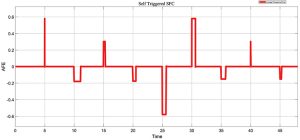A Self-Triggered Secondary Frequency Control Scheme in AC Microgrids
Siddhartha Nigam with advisers P. Sauer and A. Domínguez-García
We present a self-triggered control scheme for achieving secondary frequency control in ac microgrids. Over the last few years, the microgrid concept has been shown to be a promising approach to enable the efficient integration and management of distributed energy resources (DERs). Frequency control is a major problem in the microgrid islanded mode, because the prevalence of inverter-interfaced DERs leaves the microgrid with low or no rotating inertia. One key frequency control is secondary frequency control (SFC), which ensures the system-wide frequency returns to its nominal value following any change in the microgrid operating point. Several SFC schemes for microgrids based on a centralized, decentralized or a distributed decision-making approach have been proposed. Most of these schedule the control task in a periodic fashion with a designated execution rate; this essentially demands higher processing and communication capacity from the controller. For instance, under very small or no perturbations, the contribution of each frequency-control instance execution can be considered useless. Thus, the controller processing capacity is wasted for those instances that could have been used by various other microgrid control functions.
We propose a self-triggered framework for carrying out the SFC task. At each controller execution, the framework is also informed about the next execution time. This allows the control task to trigger itself, utilizing the computing and communication resources efficiently as it is not dependent on periodic sampling and execution. The next execution instance is obtained from a simple mathematical expression defined as a function of the average frequency error (AFE). Then, pick a function with the following rule: as the microgrid AFE approaches zero, the control period should be large and as the microgrid AFE departs from zero, the period should be small. One example is the exponential of the negative of the AFE absolute value. We use this function to define the next instance of the secondary frequency control task for the controller to execute. We test these ideas using a centralized control scheme on a six-bus islanded ac microgrid network with three inverter-interfaced DERs and three inverter-interfaced loads. We implement the microgrid model and the self-triggered centralized SFC in a Matlab Simulink environment. We perturb the loads every five seconds and plot the AFE for a fifty-second simulation as shown in Figure 22. The self-triggered framework for frequency control allows the controller to fix the AFE and bring it back to zero. The performance is slightly worse that what would be expected from a period control framework, but it is still within an acceptable time range. Furthermore, it uses fewer control execution counts, thereby reducing the burden on the controller communication and processing capacity. This research is supported by Professor Domínguez-García’s Grainger Associate Account.
